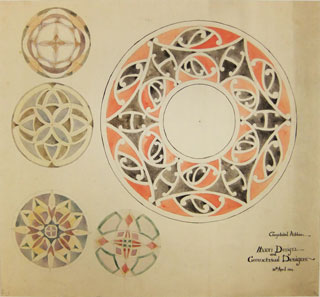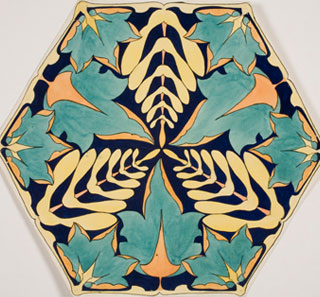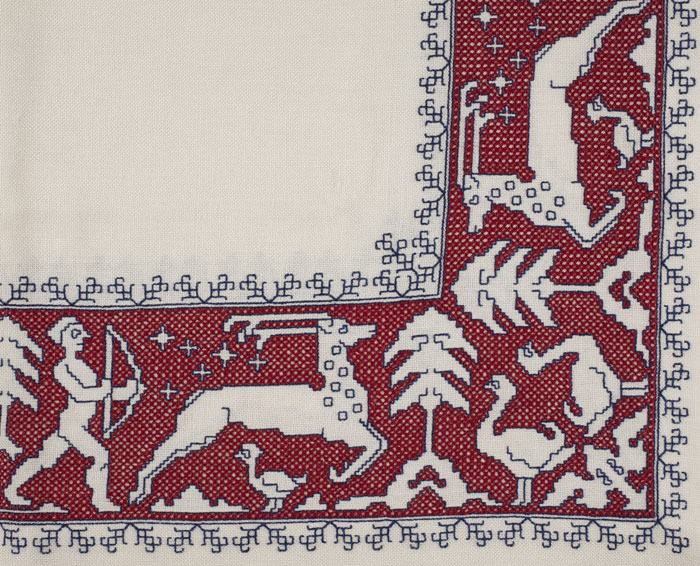Maori Design and Geometrical Designs, Chrystabel Aitken, 1924. Oil on Canvas. UC/MBL/1675

The Arts and Crafts movement
‘The British Arts & Crafts movement was more than an art movement or an artistic style. It sought a secular means of feeding the soul, combining individuality, romanticism, aestheticism, morality and social and political responsibility.’(1)
In the twentieth century, the concept of what craft meant changed significantly as traditional handicrafts were mechanised. Rather than be seen as a life-sustaining activity, it began to be associated with leisure, a middle-class activity without the pressures of profit.(2) This process was lengthy, and in the 1880s-90s in England, there was a significant distinction between valued ‘fine art’ and ‘craft’, which was often dismissed and described as ‘decorative’ or ‘applied’ art. Hence the composite term, Arts and Crafts, was born.(3) At the heart of the movement were objects to enrich daily existence and make the home beautiful.(4)

Maori Design and Geometrical Designs, Chrystabel Aitken, 1924. Oil on Canvas. UC/MBL/1675
There was some revulsion at the excesses that had arisen from the industrial revolution, and the medieval era was looked back on as an example of supposedly happier, more balanced existence: ‘work enriched life, work and leisure were enriched by beauty, and the workplace and home were testaments to lifestyles that respected the individual supporting the community.’(5)
The South Kensington system was a rigorous teaching model intended to encourage artisanship and design, and drawing and painstaking attention to technical detail were its foundation stone. This became a distinctly British Character, and featured plant/organic forms on two-dimensional surfaces, representing the ‘essence’ of the plant rather than detailed descriptions. One of the leading proponents of the movement was William Morris & Co.(6)
Many leading figures of the Canterbury Arts and Crafts movement, such as Charles Kidson, Leonard Booth, and Francis Shurrock, were recognised for their drawing skills at an early age. When schools of art and design opened in New Zealand, the easy access to both native and imported plants meant that organically influenced drawing continued. However, there were few schools with well-stocked libraries, and so students could not refer to British South Kensington images for inspiration. Calhoun writes that this actually worked in their favour, however, as ‘restrictive and endless copying’ occurred less.(7)
Since the 1906-07 Christchurch exhibition, items designed to adorn the person had been popular. This began to shift after WWII, as these fell out of favour and items for the home replaced them: clocks, fire screens, door-plates, trays, tea and coffee settings, etc.(8) This was partially prompted by the New Zealand International Exhibition of Arts and Industries in Hagley Park, which attracted nearly 2 million visitors and included examples of the Arts and Crafts movement. At the centre of the exhibition were two works by Walter Cranc and the late William Morris.(9)

Floral Design, Doris Tutill, c.1930. Watercolour on paper. UC/MBL/Uncat7
The Press would write on 3 April 1909, that ‘One of the most noticeable results of the International Exhibition, so far as art in Christchurch is concerned, has undoubtedly been the stimulation of work in the arts and crafts section […] For the first time this department of art was brought prominently into view. It was, as it were, a display of the practical application of art to the domestic side of life […] It had not then been recognised, or perhaps not fully understood, that to carry the refinements of art into the hands of the people by making the things of everyday use artistic was the surest way to cultivate an artistic taste generally.’(10)
‘What developed in New Zealand, despite a depression, was an incomparably rich period in which individuals relearned the spiritual and social value of the handicrafts, while others, as modernism and European immigrants arrived, dismissed the movement as little more than an overly fussy historical decorative anomaly.‘(11)
The Arts and Crafts movement became important to women, as they could us it for recognition of their talents, and possible financial gain.(12) After graduating from art/design schools, however, women were barred from the majority of apprenticeships, leading many to become artcraft teachers for technical, secondary, adult education and amateur classes.(13)
The development of the arts and crafts movement in New Zealand became unique in its use of Maori motifs and designs and both indigenous and introduced flora and fauna.(14).
Footnotes:
- Ann Calhoun, Simplicity and Splendour: The Canterbury Arts and Crafts Movement from 1882, (Christchurch: Christchurh Art Gallery Te Puna o Waiwhetu, 2004), 14.
- Ann Calhoun, The Arts & Crafts Movement in New Zealand 1870-1940 (Auckland: Auckland University Press, 2000), 16.
- Ibid.
- Calhoun, Simplicity and Splendour: The Canterbury Arts and Crafts Movement from 1882, 8.
- Calhoun, The Arts & Crafts Movement in New Zealand 1870-1940, 16.
- Ibid., 18.
- Ibid.
- Ibid., 168.
- Calhoun, Simplicity and Splendour: The Canterbury Arts and Crafts Movement from 1882, 8.
- Ibid., 34.
- Calhoun, The Arts & Crafts Movement in New Zealand 1870-1940, 184.
- Ibid., 17.
- Ibid., 152.
- Calhoun, Simplicity and Splendour: The Canterbury Arts and Crafts Movement from 1882, 8.

Floral Design, James Johnstone, Date unknown. Graphite and watercolour on paper. UC/MBL/2109

Untitled, Table Cloth with Assisi Border, Ngarita Johnstone, Date unknown. Embroidery and cross-stitch on linen. UC/MBL/2274